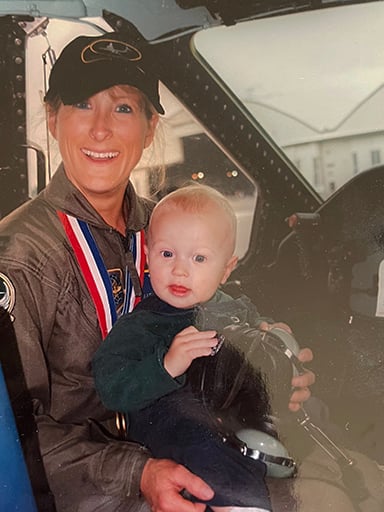She was only 22 when Kathleen Flarity began attracting attention. As one of nine women in a U.S. Army airborne class of 500 men, Flarity and her fellow female service members were being pushed hard in an environment not yet welcoming of their gender.
But the harder they pressed, the harder Flarity fought back, hurling her 110-pound frame – weighed down by 85 pounds of gear – out of an airplane and outperforming her classmates. In a move that set the stage for her future, Flarity was soon appointed leader of an all-male platoon.

Kathleen Flarity holds her son, Patrick, in the cockpit of a C-130, a military cargo plane used for medical evacuation. Today, Flarity’s son is 24 and her daughter, Tori, 22. Both are pictured with their mom in the photos at top. |
Today, the woman who joined the Army because she couldn’t afford college to fulfill her nursing dream holds advanced nursing and education degrees, wears the star of a U.S. Air Force brigadier general and uses her 41 years of combined military experience to teach other women the definition of resilience.
“I have been a woman in a predominately male environment for a long time, both in military and in medicine,” said Flarity, DNP, PhD, who has served as a commander and a critical care nurse in war zones in Afghanistan and Iraq. “I had to prove myself again and again. But instead of being resentful, I saw it as an opportunity to make an impact, to make a difference.”
Flarity is deputy director of the CU Anschutz Center for Combat Medicine and Battlefield (COMBAT) Research and associate professor in the Department of Emergency Medicine at the University of Colorado School of Medicine. Passionate about her purpose-driven work, Flarity focuses research and clinical time studying burnout and training medical professionals on preventing the fatigue that is threatening the healthcare field today.
“Systemic shortfalls have pushed millions of health workers to the brink,” Flarity said. “Some 52% of nurses and 20% of doctors say they are planning to leave their clinical practice. Shortages of more than 1 million nurses are projected by the end of the year, and a gap of 3 million low-wage health workers is anticipated over the next three years.”
In recognition of the American Medical Association’s (AMA) Women in Medicine month in September and the outstanding women who learn, teach, provide and study medicine on the CU Anschutz Medical Campus every day, we spoke with Flarity about her work and the career that influenced it.





